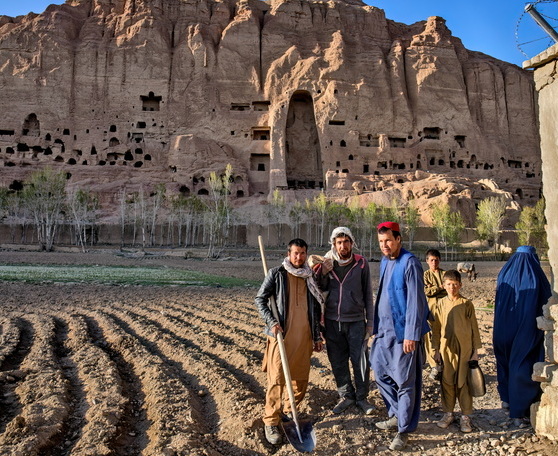
Day 1 / Kabul Arrival
Arrival and briefing at the hotel and Then you will have time to visit the bird Market known as the oldest part of Kabul where birds from all over the world is exhibited. It’s not only a bird market but a big portion of life like blacksmiths, sellers, old shops etc. is out there. You will see various types of people from different ethnicities and places of Afghanistan. Then visit an old turquoise-tiled mosque named Sakhi Shrine in the west of Kabul. This place is very sacred to Shia Muslims, who believe it to be the final resting-place of Hazrati Ali, the cousin of the Prophet Muhammad.
Overnight at Cedar Guesthouse
Day 2 / Flight to Mazar-e-Sharif and Balkh
Flight to Mazar will happen at 11:30 am in morning. Journey to Balkh, an ancient city and centre of Buddhism, Sufism and Zoroastrianism in what is now northern Afghanistan. While in Balkh, you visit Haji Piyada Mosque (the walking pilgrim) Tomb of Rabia Balkhi, a semi legendary figure of Persian literature and was possibly the first woman poet in the history of New Persian poetry, Khoja Parsa Mosque and Bala Hisar, the ancient citadel build by Alexander the Great when he destroyed the Kurush (Persian empire) and crossed Amu Darya (Auxus River) in early 330, then married Rukhshana (Ruxana) in Bacteria (Balkh) and Ummul - Bilad (Mother of the cities) to Arabs.
In the afternoon it is time to visit the Blue Tiled Mosque of Ali in Mazar-e-Sharif and the shrine of Hazrat Ali. This is one of the most famous, and most beautiful sacred sites in the Islamic world. The exquisitely-patterned decoration of the shrine, is set in an expansive white marble courtyard. Add the great flocks of white doves, and a dazzling blue sky, and you have one of the best photo locations in all of Central Asia.
Overnight at Arsalan Hotel
Day 3 / Mazar-e-Sharif and Samangan
Journey to visit Takht-i Rustam (Haibak), literal meaning the throne of Rustam, named after Rustam, a king in Persian mythology, is a hilltop settlement, well-known archaeological site in Afghanistan, in the Takth i Rostam and the adjacent Buddhist caves and stupas on top of a hill, north of Hindu Kush passes. At this location, caves were hewn out of rocks and inhabited by Buddhists. The Buddhist stupa here is in the form of a mound. It represents the earliest link to the evolution of Buddhist architecture in Afghanistan.
Overnight at Arsalan Hotel
Day 4 / Mazar-e-Sharif to Bamyan
Your journey will continue by drive towards north of Afghanistan passing through Hindukush ranges from Salang a set of Tunnels built by Soviets in mid 1960s once it was the 2nd longest tunnel in the world. You will reach Mazar-e-Sharif in the evening passing through 5 provinces Bamyan, Parwan, Bghlan, Samangan and Balkh and you will see a lot.
Overnight at Noorbandqala Hotel
Day 5 / Bamyan and Around
Early in the morning we will leave hotel hiting the road towards Bamyan and while in Bamyan we will have time to visit Buddha Niches. The Buddha’s of Bamyan were two 6th century monumental statues of standing Buddha carved into the side of a cliff in the Bamyan valley in the peaceful Hazarajat region of central Afghanistan and were dynamited and destroyed in March 2001 by the Taliban. Shahr-e Gholghola also (City of Screams) is 13th century city in Bamyan, Afghanistan which was conquered by Gengis Khan after months of surrounding. The ruins still remain close to the Bamyan town and Shahr-e Zuhak also known as The Red City is an historic city ruins in Bamyan, Afghanistan which was once home to 3,000 people. This city used to be primary defence for the basin.
Overnight at Noorbandqala Hotel
Day 6 / Band-e-Ameer
Day five would be a day to visit the blue lakes of Band-e-Amir, a series of six deep blue lakes separated by natural dams made of travertine, a mineral deposit. The name Band-e Amir literally means "Commander's Dam" which is believed by some to be reference to Ali, the first Imam of Muslims (Shias) and the fourth Caliph of Islam (to Sunnis) and The area is dominated by ethnic Hazaras, who make up around 23% of Afghanistan's population. Band-e Amir was to become Afghanistan's first national park in the 1960s but this was delayed due to political crises and the decades of wars. In 2004, Band-e Amir was submitted for recognition as a World Heritage site. In 2009, Band-e Amir was finally declared Afghanistan's first national park. As of 2013 tourists visit the Band-e Amir National Park every year. Journey back to Bamyan.
Overnight at Noorbandqala Hotel
Day 7 / Kabul and around
Drive to Kabul in the morning. Depends on time. Visit to Shah Do Shamshira (the king with two swords) Mosque at the heart of Kabul city built by the King Amanullah Khan in the memory of the Arab King who forced Kabul people in to Islam in the early 683 with his two swords. Then we will take you for an overall view of Kabul city at Bibi Mahro Hills. Drop at the airport to make sure you will have your flight back home on time.